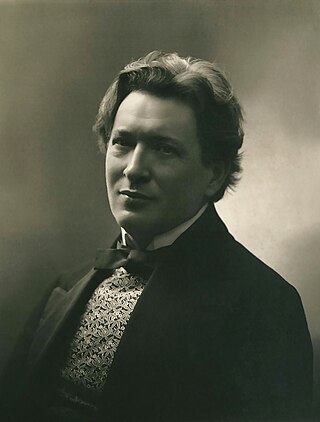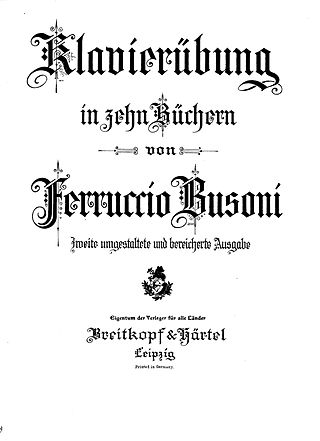Related Research Articles

Ferruccio Busoni was an Italian composer, pianist, conductor, editor, writer, and teacher. His international career and reputation led him to work closely with many of the leading musicians, artists and literary figures of his time, and he was a sought-after keyboard instructor and a teacher of composition.

Egon Petri was a Dutch-American pianist.

An die Jugend(BV 254) is a sequence of pieces of classical music for solo piano by Ferruccio Busoni.

Kaikhosru Shapurji Sorabji was an English composer, music critic, pianist and writer whose music, written over a period of seventy years, ranges from sets of miniatures to works lasting several hours. One of the most prolific 20th-century composers, he is best known for his piano pieces, notably nocturnes such as Gulistān and Villa Tasca, and large-scale, technically intricate compositions, which include seven symphonies for piano solo, four toccatas, Sequentia cyclica and 100 Transcendental Studies. He felt alienated from English society by reason of his homosexuality and mixed ancestry, and had a lifelong tendency to seclusion.

The Fantasy on Themes from Mozart's Figaro and Don Giovanni, S.697, is an operatic paraphrase for solo piano by Franz Liszt, based on themes from two different Mozart's operas: The Marriage of Figaro, K.492 and Don Giovanni, K.527.

Fantasia contrappuntistica(BV 256) is a solo piano piece composed by Ferruccio Busoni in 1910. Busoni created a number of versions of the work, including several for solo piano and one for two pianos. It has been arranged for organ and for orchestra under the composer's supervision.

Lazar "Larry" Sitsky is an Australian composer, pianist, and music educator and scholar. His long term legacy is still to be assessed, but through his work to date he has made a significant contribution to the Australian music tradition.

Arthur Friedheim was a Russian-born concert pianist and composer who was one of Franz Liszt's foremost pupils. One of Friedheim's students was Rildia Bee O'Bryan Cliburn, the mother of 20th-century piano virtuoso Van Cliburn.

Alexander Brailowsky was a Russian-born French pianist who specialised in the works of Frédéric Chopin. He was a leading concert pianist in the years between the two World Wars.

The Piano Concerto in C major, Op. 39 (BV 247), by Ferruccio Busoni, is one of the largest works ever written in this genre. The concerto lasts around 70 minutes and is in five movements; in the final movement a men's chorus sings words from the final scene of the verse drama Aladdin by Adam Oehlenschläger, who also wrote the words of one of the Danish national anthems.

Doktor Faust is an opera by Ferruccio Busoni with a German libretto by the composer, based on the myth of Faust. Busoni worked on the opera, which he intended as his masterpiece, between 1916 and 1924, but it was still incomplete at the time of his death. His pupil Philipp Jarnach finished it. More recently, in 1982, Antony Beaumont completed the opera using sketches by Busoni that were previously thought to have been lost. Nancy Chamness published an analysis of the libretto to Doktor Faust and a comparison with Goethe's version.

Turandot(BV 273) is a 1917 opera with spoken dialogue and in two acts by Ferruccio Busoni. Busoni prepared his own libretto, in German, based on the play of the same name by Count Carlo Gozzi. The music for Busoni's opera is based on the incidental music, and the associated Turandot Suite, which Busoni had written in 1905 for a production of Gozzi's play. The opera is often performed as part of a double bill with Busoni's earlier one-act opera Arlecchino.
Roy Ewing "Robert" Agnew was an Australian composer, pianist, teacher and radio announcer. He was described as "the most outstanding of the early twentieth century Australian composers" by Morris Hinson.
Antony Beaumont is an English and German musicologist, writer, conductor and violinist. As a conductor, he has specialized in German music from the first half of the 20th century, including works by Zemlinsky, Weill, and Gurlitt. As a musicologist, he has published books on Busoni, Zemlinsky, and Mahler.

The Klavierübung, by the Italian pianist-composer Ferruccio Busoni, is a compilation of piano exercises and practice pieces, comprising transcriptions of works by other composers and original compositions of his own.

Elegies, BV 249, by the Italian composer Ferruccio Busoni is a set of solo piano pieces which can be played as a cycle or separately. Initially published in 1908 with six pieces, it was subsequently expanded to seven by the addition of the Berceuse. The set of seven takes just over 40 minutes to play.

The Bach-Busoni Editions are a series of publications by the Italian pianist-composer Ferruccio Busoni (1866–1924) containing primarily piano transcriptions of keyboard music by Johann Sebastian Bach. They also include performance suggestions, practice exercises, musical analysis, an essay on the art of transcribing Bach's organ music for piano, an analysis of the fugue from Beethoven's 'Hammerklavier' sonata, and other related material. The later editions also include free adaptations and original compositions by Busoni which are based on the music of Bach.

Ferruccio Busoni composed his Concerto for Piano and String Quartet in D minor, Op. 17, BV 80, in 1878, at the age of twelve. The original title was Concerto per piano-forte con accompagnamento di quartetto ad arco, Op. 17. Conceived for string quartet, the piano can also be accompanied by a string orchestra as Concerto for Piano and Strings, the title under which it was published in 1987.
References
- Dyment, Christopher (1978). "Ferruccio Busoni: His Phonograph Recordings," ARSC Journal, 10:2/3, pp. 185-187. Accessed 7 July 2009.
- Roberge, Marc-André (1991). Ferruccio Busoni: a bio-bibliography. New York: Greenwood Press. ISBN 0-313-25587-3
- Sitsky, Larry (2008). Busoni and the Piano. The Works, the Writings, and the Recordings. (2nd ed.) Hillsdale, NY: Pendragon Press. ISBN 978-1-57647-158-6 [First edition, Westport: Greenwood Press,1986. ISBN 0-313-23671-2]
